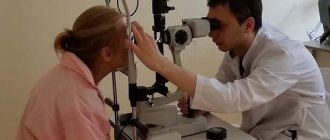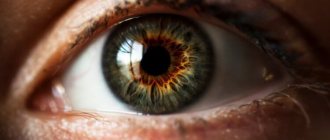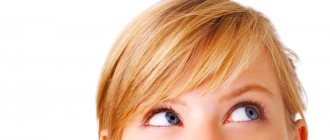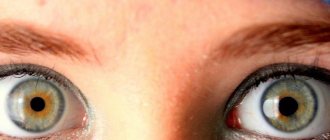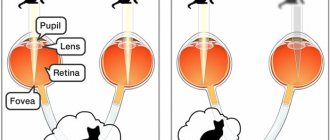What does Komarovsky advise to do with heterotropia?
If the baby continues to squint his eyes after 5-6 months, the pediatrician strongly recommends showing him to an ophthalmologist, who will conduct an examination to identify the cause of oculomotor disorders and prescribe competent treatment for strabismus. In addition, it is necessary to perform special eye exercises daily, which will help straighten vision and strengthen the eye muscles.
Komarovsky offers another simple solution to the problem.
To do this, you need to put the baby on the pillow at an angle of 45 degrees, take some bright toy and slowly move it in front of his eyes, first clockwise and counterclockwise, and then up and down.
Please note that the toy should be 50-70 cm from the eyes, but not closer! You can watch the video for better clarity.
Read on the topic: What should parents know when treating strabismus in newborns?
Until what age can strabismus develop?
Hereditary diseases appear in the first year of a baby’s life. If pathologies of the visual organs are present from birth, then the disease manifests itself early in the child - before 1 year. Strabismus may also appear early on the background of serious neurological pathologies. In the absence of proper treatment, the child's strabismus rapidly progresses, and the angle of the heterotropic disorder increases. This is why early diagnosis is important - the earlier the pathology of the visual organs is detected, the greater the chance that the defect can be corrected without surgery.
To restore binocular functions, you will have to wear glasses, perform special exercises, and use equipment. Conservative treatment methods are used within a year from the date of diagnosis. If no improvements are recorded within a year, then surgery is performed. The optimal time for surgery is age 3-5 years.
What influences the appearance of the disease, does strabismus develop after 5 years? Yes, if there is a predisposition to this pathology: heredity, myopia, astigmatism, high hyperopia. Also, strabismus in children can occur due to injuries, infectious diseases, and disorders of the central nervous system.
What is strabismus in a newborn?
Immediately after birth, the child begins to adapt to the world around him and learns to control his body. While in the womb, the baby does not have the opportunity to acquire skills related to the organs of vision, so the formation of their functions to a greater extent occurs after birth.
The first few weeks, and sometimes months, a connection is established between the brain centers responsible for vision and the eyes themselves. During this period, a child who is not yet adapted to a full life cannot always control eye movements. That is why they often behave inconsistently.
Up to two months, slight asymmetry of the pupils is considered normal.
The imaginary effect of strabismus can occur due to the peculiarities of the location of the bones of the child’s skull or the skin folds in the corners of the eyes. The baby's facial features quickly change and take on a more regular shape, so within a month the apparent defect disappears.
In most cases, strabismus (or strabismus) in newborns is not a pathology, but a natural condition. It is definitely impossible to diagnose strabismus in the first month of life. The pupils are finally established by two, less often by six months. If after six months the defect does not go away on its own, this may indicate true strabismus, which needs to be treated.
If strabismus persists after six months, you need to sound the alarm
If there are concerns about congenital eye pathology, you should regularly visit an ophthalmologist. Newborns are examined by specialists in the maternity hospital in the first hours after birth. Routine examinations for suspected strabismus are carried out at two, four and six months. The doctor determines the dynamics of the development of the defect and by six months makes a decision on the need for treatment.
Symptoms of strabismus
In addition to the obvious deviations, which attentive parents will definitely notice, a child with strabismus may complain of:
- diplopia (double vision). Even if the baby does not yet know how to speak, parents may notice that it is difficult for him to pick up this or that object the first time. The child experiences difficulties when drawing and active games - all because the objects on which he tries to focus his vision are double.
- decreased vision. Often with strabismus, amblyopia develops - lazy eye syndrome, in which the affected eye ceases to participate in the visual act.
- “flattening” of the perception of the surrounding world. Due to the violations, the picture does not look three-dimensional to the baby; he cannot assess the depth and distance to objects.
- discomfort in the eyes and headache after watching 3D in a cinema.
If your eyes run in different directions
If a newborn’s eyes squint in different directions, then this may be one of two types of strabismus:
- Functional. This is the name of imaginary strabismus, which was discussed above. It is not a disease. This condition, in addition to the special structure of the skull, is also explained by the fact that the child, who was in the stage of intrauterine development, did not have the need to focus his gaze. For this reason, the eye muscles are not yet trained at the time the baby is born. The areas of the brain that are responsible for the motor function of the eyes reach the desired level of development only by 3-4 months. Until then, eye movements occur uncoordinated.
- Persistent. With this disorder, the pupils cannot align on the same axis and are therefore directed in different directions. If this pathology is observed in a child from birth, then strabismus will not go away on its own by 6 months.
Strabismus in infants - pathology
If a newborn's eyes cross even after six months of life, this can be a serious concern for parents. This situation suggests that such a problem can remain for life if measures are not taken in time. Reasons for persistence of strabismus may include:
- infectious diseases during pregnancy;
- infection suffered by a child in the first months after birth;
- proximity of toys to the child;
- genetic factor;
- neurological diseases;
- difficult labor;
- eye diseases;
- heat;
- physical trauma to the eyeballs.
If a baby has a sideways glance that has not disappeared by 5-6 months, it is worth visiting a pediatric ophthalmologist.
How to help your baby?
If a pediatric ophthalmologist diagnoses strabismus in your child, he will prescribe appropriate treatment. The complex use of medications, special exercises to strengthen muscles and devices to stimulate the “lazy” eye will help the baby overcome this unpleasant illness.
In order to prevent the development of persistent strabismus in a healthy baby, you need to adhere to certain measures to protect the eyes of the newborn. If you do not adhere to preventive rules, then physiological strabismus in infants can develop into a serious pathology.
- since a baby under 3 months is farsighted, do not buy small toys for him; large objects will be more comfortable for his eyes;
- there is no need to bring toys or other objects too close to the child’s visual organs, trying to focus on them, the baby can overstrain the eye muscles and harm the visual organs;
- Try to arrange the room so that the awake baby has enough light, which will stimulate the movement of the eye muscles.
How to treat strabismus
Treatment tactics for strabismus in children are tailored individually, taking into account the type of disease and concomitant pathologies. This should be done by an ophthalmologist or strabismologist - a specialist who deals with the problem of strabismus.
Surgery to correct strabismus
Often, surgical intervention is required to correct the situation (especially with congenital pathology). Sometimes properly selected conservative treatment is enough - special techniques, exercises, exercises on devices and at home. The following may also help:
- temporary occlusion of the healthy eye;
- specially selected glasses or lenses. Lenses can also be used for occlusion or penalization during treatment for strabismus; this is more convenient than adhesives on the eyes.
In addition, the attitude of parents to long and painstaking work is important: children who have undergone treatment for strabismus need further observation to consolidate the effect of treatment and maintain the correct position of the eyes.
Strabismus in children. causes
We found out in this article how to cure and when strabismus goes away, but why do some children suffer from this disease and others not? Why does this disease appear? The reasons why it may appear in a child are different:
- Viral and chronic diseases suffered by the mother during pregnancy can affect the health of the baby;
- difficult childbirth;
- various infectious diseases and inflammatory processes in the newborn;
- external damage and trauma to the organs of vision;
- hereditary predisposition;
- obvious violation of eye hygiene;
- incorrect mode of visual function, when toys are always located too close to the baby’s face in the crib and stroller.
This pathology belongs to the small number of diseases that can almost always be diagnosed by the parents themselves, without the participation of a doctor. You just need to carefully monitor the development of visual functions. And when the newborn’s strabismus passes, a caring parent will immediately notice. You just need to carefully monitor the baby.
Treatment
Why children are born with strabismus, whether it needs to be treated and how to do it is determined by a pediatric ophthalmologist. The physiological form goes away on its own by 4–6 months and does not require any treatment. To treat other types, various methods are used. When strabismus goes away is an individual question. It depends on the characteristics of the body and the speed of development of the baby.
Komarovsky's opinion
The famous children's doctor Oleg Komarovsky does not consider strabismus in newborns to be a serious pathology. He points out that in the vast majority of children, strabismus disappears by the age of four months. If the signs remain, timely examination by an ophthalmologist and proper treatment can get rid of the problem without any consequences.
In his opinion, how long strabismus will last cannot be predicted in advance. All doctors indicate the average time for vision restoration to be within 3–6 months.
Watch the pediatrician's video explanation:
Exercises
The main method of treating strabismus in newborns and infants is gymnastics. There are several options for exercises that are selected according to the age of the child:
- a bright toy is moved in front of the newborn’s face, at a distance of 40 cm, from side to side, trying to get him to follow it;
- bring the toy closer to the newborn’s face, then move away;
- sit the child on a chair, turn on the lamp, close one eye and invite the baby to look at the lamp with the other for a few seconds.
Exercises are done for at least two hours during the day, distributed over several approaches.
Surgery
The operation is carried out according to strict indications. When paralytic strabismus is detected in a newborn, there is no effect of conservative therapy. The intervention consists of plastic surgery of the eye muscles - their shortening or lengthening as necessary.
After the operation, the newborn is instilled with antibacterial and anti-inflammatory drops and healing agents. The operation eliminates only a cosmetic defect, but does not restore vision. Therefore, the child must be prescribed glasses.
Other methods
In addition to exercises, a child with strabismus needs vision correction with glasses. They are prescribed to be worn from 8–12 months. Glasses are prescribed taking into account the type of visual impairment - astigmatism, farsightedness or myopia.
Pleoptics - this method is used to correct amblyopia. This is what is called lazy eye syndrome, when strabismus develops on one side. The healthy organ of vision is covered with a tight bandage. The squinting eye has to work hard to straighten it.
Who is at risk?
Above we examined cases of physiological strabismus that do not require correction. They disappear on their own without special treatment. But there are times when parents need to be more attentive to their child’s eyes and, if pathology is suspected, immediately contact a pediatric ophthalmologist.
- Some relatives have eye diseases. Doctors note that the tendency to myopia is inherited. Even if one of the parents or close relatives has vision problems, this will definitely be passed on to the child. Genetically determined weakness of the eye muscles not only changes the quality of vision, it can cause pathological strabismus.
- In the early stages of gestation, when the tissues responsible for vision were formed and developed in the embryo, the mother suffered from certain diseases. It could be cytomegalovirus, toxoplasmosis or herpes. These viral illnesses can negatively affect the development of a child's visual organs.
- Difficult or early labor can also cause the newborn's systems to malfunction and lead to abnormal asymmetries.
- Viral, infectious and inflammatory diseases at the initial stage of a baby’s life can lead to strabismus.
Need for therapy
If there is a slight deviation from the norm in children, parents may not pay significant attention to this problem. However, you should know that ignoring even the slightest strabismus in the future is fraught with consequences such as:
- stop in the development of a squinting eye;
- difficulties in eliminating the defect due to the habit of the eye being in the wrong position;
- development of amblyopia - “lazy eye”;
- decreased vision.
In addition to a defect in appearance, strabismus can cause deterioration of vision in the squinting eye
The reason for the deterioration of visual perception lies in the high adaptability of the child’s brain. Unable to compare the image from the healthy and squinting eye, the brain begins to receive and process information only from the eye that is functioning correctly. This causes gradual loss of vision in the affected eye due to its detachment from the transmission of images and visual images.
Features of infant vision
- If you have strabismus, you should avoid excessive strain on the organs of vision. Children under 5 years old should not watch TV for more than 30 minutes a day. In case of such a problem, it is advisable to delay the introduction of the child to the computer as long as possible.
- When a child goes to school, the load on the visual organs increases significantly. In order not to aggravate the manifestation of heterotropia, posture must be correct, and while doing homework, you must take breaks every 30-40 minutes.
- Badminton and table tennis help train the eye muscles for strabismus. It is better to avoid strength sports, since if you receive a head injury during exercise, you can aggravate the course of the disease.
A newborn is born absolutely helpless - this also applies to his vision. The eyes of a newly born baby have some features:
- the eyeball has a flattened shape, whereas in an adult it is absolutely round;
- Because of this eye shape, the baby is born farsighted;
- the first day the newborn reacts only to the light source;
- until the second month of life, gaze fixation occurs only on large objects, the baby sees the rest blurry;
- after the third month, the newborn can distinguish all objects, but can focus his gaze for a short time;
- lack of binocular vision - the baby sees the image not with two eyes at the same time, but with each one separately.
Causes of the violation
The occurrence of the defect is based on a number of reasons, many of them are physiological in nature. These include:
- damage to the centers of the baby’s brain, which are responsible for synchronizing the actions of the eyes during a pathological pregnancy or difficult childbirth;
- viral infectious diseases that disrupt the functioning of the baby’s body;
- some diseases of the mother during pregnancy;
- constant stress or illness that causes severe crying in the baby and increases desynchronization of the eyes;
- hereditary pathology that is observed in the child’s parents or close relatives;
- birth or postpartum trauma (damage) to the eye;
- mistakes in baby care.
If the parents have pathology, the baby will inherit strabismus in 4/5 cases. A birth defect of this kind may be caused by a birth injury, or may be caused by microtraumas that form in the system of the posterior longitudinal fasciculus, due to oxygen starvation or damage. The consequence of such a lesion may be persistent divergent or convergent strabismus in an infant.
Symptoms of the disease
The task of parents is to recognize persistent strabismus in children as early as possible and begin treatment in a timely manner. Parents should know when strabismus in newborns goes away, and at 6 months begin to sound the alarm if the child has the following symptoms of the disease:
- the child is unable to direct his eyes to one point in space;
- to look at an object, the child needs to bend over or turn his head to the side;
- when the camera flash or a switched-on lamp is pointed at the eyes, the light in the pupils is reflected asynchronously;
- the baby bumps into objects because it is difficult for him to see them.
Even if you do not see obvious strabismus in a child, the above symptoms should alert you and prompt you to immediately see an ophthalmologist.
Types of strabismus
Depending on the underlying symptoms, experts identify up to 25 different types of the disease. Thus, strabismus in children under one year of age can be true or imaginary - and the latter is not a pathology. With imaginary - or false - strabismus, the feeling of squinting eyes appears due to the structural features of the face: close-set eyes, a wide bridge of the nose or an overdeveloped epicanthus - the fold of the upper eyelid. In addition, the cause may be the immaturity of the nerve and visual centers.
Types of strabismus
False strabismus is characteristic of an infant: it goes away on its own as it grows and facial features change, usually within the first 6 months. Strabismus of a newborn child does not require treatment. If after six months the symptoms have not disappeared, the child should be shown to an ophthalmologist to exclude or confirm true strabismus.
Primary and secondary strabismus
Depending on what disease formed the basis for the onset of the disease, strabismus can be primary or secondary.
Primary strabismus appears as a result of refractive errors - farsightedness, myopia, astigmatism. Secondary - due to pathology of eye tissue: cataracts, diseases of the fundus or vitreous body.
Friendly and unfriendly strabismus
These types of diseases differ from each other in the degree of eye mobility with pathology. If, with the friendly option, his (or theirs - if both eyes are squinted alternately) mobility in any direction is preserved, then with the unfriendly option, mobility is limited or absent. Problems with organ mobility can be caused by paresis, injuries, and abnormalities in the functioning of the extraocular muscles.
Convergent and divergent strabismus
With convergent strabismus in children (isotropy), one or both of the child’s eyes converge towards the inner corners: as if he is looking at the bridge of his nose. This is the most common type of childhood strabismus, often manifesting itself in the first year of life. With insufficient or ineffective treatment, isotropy can lead to farsightedness.
Divergent strabismus in children - exotropia - is characterized by deviation of the eyes towards the temples. Most often it occurs between 1 and 6 years of age and can lead to myopia.
Vertical and horizontal strabismus
It happens that the affected eye does not deviate towards the corners, but up or down. Such conditions are called hyper- and hypotropia. With hypertropia, parents may notice that the child seems to be trying to examine his eyebrow. The hypotropical eye, on the contrary, is directed downwards, towards the cheek.
Most often, the cause of this type of strabismus lies in the improper functioning of the extraocular muscles.
This is not a complete list of types of the disease: symptoms can appear in various combinations. In addition, there are other, rarer types of the disease that are difficult to list in one article.
